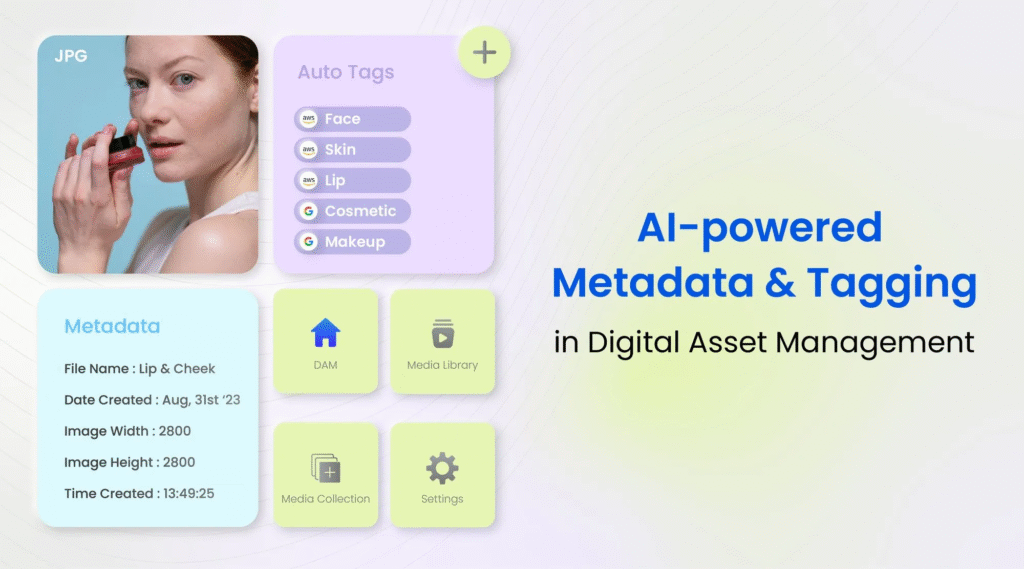
In the ever-evolving digital landscape, businesses are constantly creating and managing a wealth of content — from images and videos to documents and audio files. As the volume of digital assets grows, the challenge of organizing, searching, and tracking these assets becomes more complex. Traditional methods of managing assets often fall short in handling large volumes of content. This is where Digital Asset Management (DAM) systems come into play.
A core feature that drives the efficiency of a DAM system is metadata. Metadata refers to the descriptive data attached to digital assets, making them more accessible, searchable, and organized. It enables smarter searches, better asset tracking, and streamlined content management. In this blog, we’ll explore the role of metadata in DAM and how it enhances content management and collaboration. We’ll also dive into how Wizbrand, a leading DAM solution, leverages metadata to optimize digital workflows.
What is Metadata in DAM?
At its core, metadata is data that describes and provides information about other data. In the context of DAM, metadata is a set of descriptive attributes added to digital assets such as images, videos, documents, and more. These attributes can include things like keywords, descriptions, creation dates, author names, and tags. By associating metadata with digital assets, organizations can make their content more easily searchable, organized, and manageable.
For instance, instead of manually searching through hundreds of files, a digital marketer can use metadata such as campaign names, project types, or target audience tags to quickly locate the right assets. The power of metadata lies in its ability to transform how assets are found, used, and tracked.
How Metadata Transforms Search Capabilities
One of the most valuable aspects of metadata in a DAM system is its impact on search functionality. Without metadata, searching for specific assets within a sea of files can become a frustrating and time-consuming process. Traditional file systems rely on basic folder structures and filenames, which often don’t provide enough context for efficient searches.
With the integration of metadata, DAM systems like Wizbrand offer advanced search capabilities. Metadata allows users to search using various filters like keywords, dates, asset types, and custom tags, ensuring faster and more accurate results.
For example, a content team might need to find all images from a recent marketing campaign. Rather than searching manually through countless folders, they can quickly pull up the images by searching for specific metadata tags, such as “2025 campaign,” “social media,” or “product images.” This drastically reduces the time spent searching for assets and ensures that the team can find exactly what they need in minutes.
Asset Tracking with Metadata: Streamlining Content Management
Tracking assets is an essential part of any content management process. As businesses manage more digital assets, it becomes increasingly important to track the usage, updates, and status of each asset throughout its lifecycle. This is where metadata plays a pivotal role.
Metadata allows businesses to monitor the lifecycle of assets, including when they were created, last edited, or used in various campaigns. With this level of tracking, content teams can keep tabs on which assets are actively in use, which are outdated, and which need to be archived or updated.
For instance, Wizbrand enables users to track assets based on metadata such as the last modified date, version history, and usage frequency. This ensures that content is continuously updated, and teams can identify and remove obsolete assets. Metadata-driven asset tracking helps businesses maintain a clean and organized digital library, reducing redundancy and enhancing efficiency.
Enhancing Team Collaboration with Metadata
In today’s collaborative work environment, teams across various departments — marketing, design, content creation, and sales — often need to access and share the same assets. Effective collaboration depends on having the right assets available to the right people at the right time. This is where metadata shines.
By tagging digital assets with clear and consistent metadata, teams can ensure that everyone can easily find and use the assets they need. Whether it’s a creative team searching for visuals or a marketing team looking for campaign content, metadata enables efficient collaboration by making assets discoverable across departments.
Wizbrand helps streamline collaboration by allowing teams to tag assets with custom metadata fields that suit their specific needs. This could include tags for campaigns, target demographics, project deadlines, or content types, making it easy for teams to search and access the right assets when working on cross-functional projects.
Metadata and SEO: Boosting Visibility and Discoverability
For SEO professionals and digital marketers, metadata plays a critical role in enhancing the visibility and discoverability of content. When applied to assets like images, videos, and documents, metadata can include SEO-relevant information such as keywords, descriptions, alt text, and titles. This helps search engines understand the content and context of the assets, improving their chances of ranking higher in search results.

For example, Wizbrand offers SEO Management Software that enables users to optimize metadata for search engines. Marketers can ensure that all assets are tagged with relevant keywords, descriptions, and SEO-friendly metadata that improve content ranking and make assets more easily discoverable by search engines.
By utilizing metadata for SEO purposes, businesses can ensure that their digital assets are optimized not only for internal search within the DAM system but also for external visibility through search engines.
How Wizbrand Leverages Metadata for Efficiency
As one of the Best Digital Asset Management Software available today, Wizbrand fully utilizes metadata to help businesses streamline their digital workflows. The platform enables teams to tag assets with a wide range of metadata fields, from basic information like file type and size to more specific attributes like project tags, version history, and approval statuses.
With Wizbrand, metadata management is automated, saving teams valuable time and reducing the risk of errors. The software’s intuitive interface makes it easy to add, edit, and search metadata, enhancing the overall user experience. Teams can organize assets efficiently and search through large libraries in seconds, allowing them to focus on their creative and marketing efforts.
Conclusion: Unlock the Full Potential of Metadata with Wizbrand
Metadata is a game-changer when it comes to managing and tracking digital assets. By enabling smarter searches, better tracking, and more efficient collaboration, metadata helps businesses streamline their content management processes. Wizbrand offers a powerful DAM solution that makes full use of metadata to optimize workflows, improve team collaboration, and enhance asset visibility.
If you’re ready to take your digital asset management to the next level, explore Wizbrand today. With its powerful metadata-driven capabilities, Wizbrand empowers businesses to manage, track, and optimize their digital assets like never before. Start using Wizbrand now and unlock smarter content management and enhanced productivity for your team!